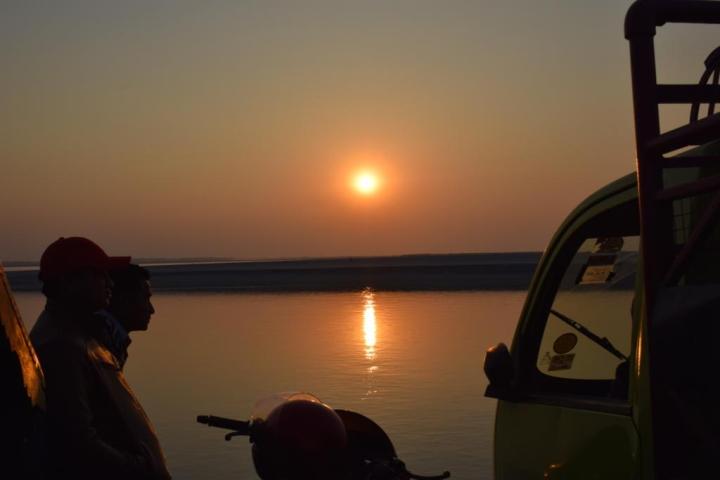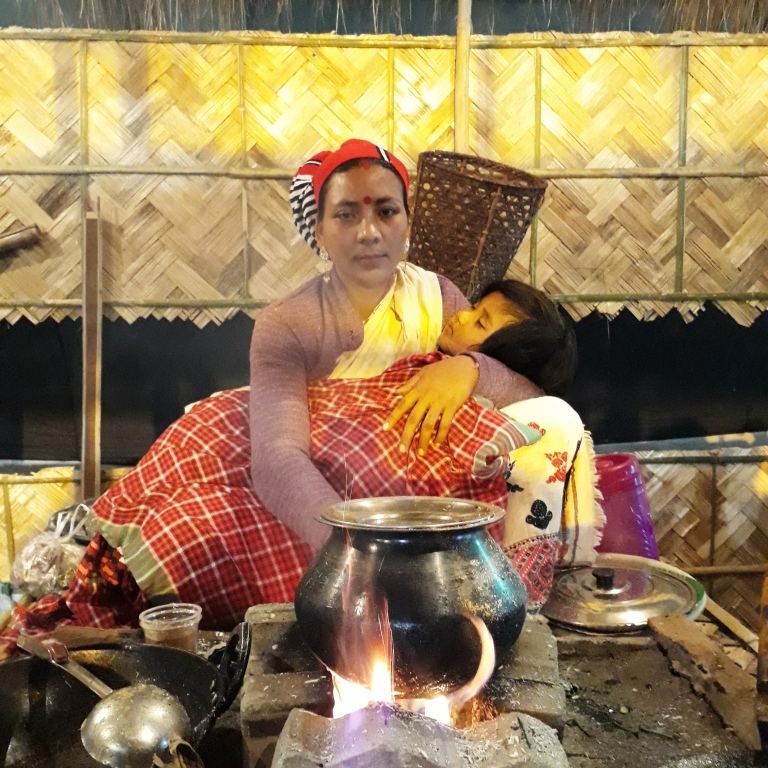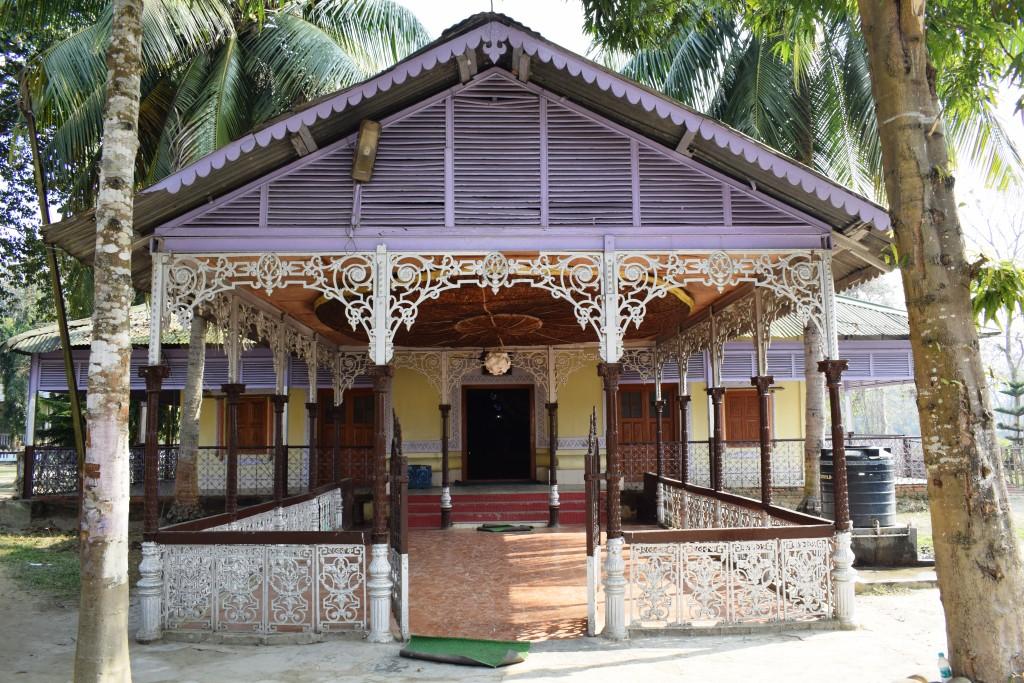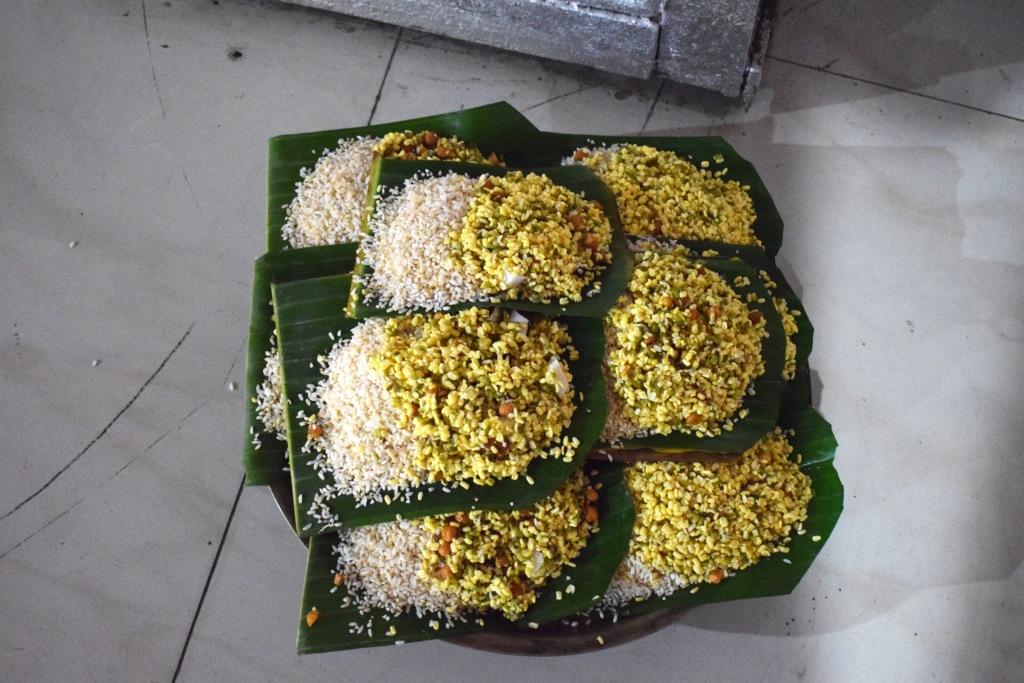A cradle of tribes and culture, life here is in sync with Nature. It transports us into the world of boats, fishing, hand weaving, writing on barks, making masks
Words & Photos: Ambica Gulati
Headphones on, she is casually lying in her bamboo home when we walk in. Surprisingly she speaks in Hindi and could have been any teenager, except that she lives on an island, in a bamboo hut built on stilts. This home was built by her parents. This is life in the tribal belt of Majuli, India’s largest river island.

Back from school, she is enjoying some free time while her mother is weaving on the loom under the stilts. Our invasion startles her, but hiding that astonishment, she proudly shows us around her home. A single partition separates the bedroom from the open kitchen. On a pole hung some shawls that are worn by the women of her tribe–the Mising. Her mother has woven these mekhla chadars.
In the meanwhile, the mother has hastily left her loom and rushes into the home, seeing the invaders. She doesn’t seem too pleased with us and converses with her daughter in their native language. We plead guilty with our expression, gesturing that we come as curious travellers, not thieves or warriors. Luckily, the teenager has posed for a few good pictures and with smiles of gratitude, we walk out.

This is how the Mising tribe lives in Majuli, the island that might be submerged over the next decade. As the area is prone to floods during the monsoon, the tribes living near the shores build their homes on stilts. The women weave cotton and silk dothes. Very little is sold, most is consumed for self and the family, some give to the satras or Vaishnava monasteries, on the island. The 22 satras are the core of the island, giving it the unique man-made connection with the creator.

How was Majuli named?
Steeped in Vaishnavite culture and tribal lives, the island was called MazzaJ, Majoli until it became Majuli in the18th century. Majoli means land in the middle of two parallel rivers. The Brahmaputa was in the north and the Burhidihing in the south, the two meet at l.akhu. However, a series of earthquakes from 1661-1696, a catastrophic flood in 1750 and the Brahmaputra split into two branches. One remained on the original path and the other went towards the Burhidihing channel, and Majuli was forrned. Majuli, earlier known as Ratnapur, was also the capital of the powerful Chola kingdom.
The island had an area of l,150 sq km, but erosion has reduced it to around 352 sq km. There have been concerns about its sinking and shrinking conditions, nevertheless a nomination was sent to UNESCO for making it a world heritage site.
Ferry to Majuli
Must of the people I talk to, refer to Majuli as the cradle of a long-gone culture. Fishing, farming, dairy, weaving, mask-making, devotional dances, idyllic pollution-free life—my mind built up images of a heavenly abode. But Majuli is a down- to-earth experience.

The adventure begins at the ghat, from where you board the ferry. If you are used to luxury travel, then God help you. The government-run ferry costs a mere INR 15 per person which is easy on the pocket, but you share that little space with cars, motocydes, luggage, men who stand on the roof, and women and children who are cramped in the boat’s tiny quarters. There is not an inch of space to wriggle your butt. The good part, it’s a sail time of just 30 minutes from the ghat to Majuli.

I take my position near a car (the owners sit inside), put on my headphones, the breeze ruffles my hair and my mind drifts to another world, even as the waves shimmer under the setting sun. Despite the load, the ferry is speedy. The waves carry it with ease, undeterred by the weight of this overloaded vehicle.
The first look of the heavenly abode doesn’t seem too heavenly. Concrete roads, electricity poles and the litter of poop! It takes us by surprise, probably because the islands in movies are so different! The boats are swanky, the men are leaner and the piers are clean. But Majuli is real with grim shores, until you start travelling inwards.

Once the jeep takes us over the sand and onto concrete roads, it looks like a small town in the plains. There are some concrete homes. A passenger tells me that there are government offices, hospital, schools, and even petrol pumps. The island was declared a district in 2016. But the concrete begins to disappear and eco-friendly bamboo and sand homes appear. As we drive past rows of trees and green shrubs, my spirits are lifted by the heavenly cool breeze. The magic of Majuli is seeping into my soul.

With dusk giving way to night, the breeze has a nip and we go to sleep early. But it is the early morning vista that brings life into the stressed-out city lungs. The mist swirls over the trees, rests on the roads, camouflaging the birds pecking for food. Friendly goats nibble on the dewy grass. The village is waking up and young ones giggle at the sight of this pajama-clad stranger. Women are busy with their daily chores. The sun is trying hard to break through the misty clouds. I also try hard to talk to the children, whose only response is more giggles
Satras & Masks in Majuli

While there are cars and even buses, I was told, most of the times people use cycles or walk. We have a jeep. The culture of the island centres revolves around the satras where Vishnu and his avatars are worshipped. On land, it is recognised as the “nerve centre of Vaishnavite art and culture”. The culture was established by Assamese saint Srimantu Sankardeva and his disciple Madhavdeva in the 16th century. The first satra was ‘Manikanchan Sanjog’, later 65 more were established. But now only 22 remain. Sattriya culture includes ancient dances such as Jumora, Chali, Noyua, Nande Vringee, Sutradhar, Ozapali, Apsara, Satri Krishna Dasavatar and more.
Among the ancient crafts are cane fans, masks and sanchipat (tree bark used for writing), boat making and others. And we want to see it all, but time does not permit too much. Another tradition that lives on in Majuli is bhaona or plays based on the scriptures related to Vishnu and his avatars. These plays are the late night entertainment for the people, lasting uptil 4am in the morning. While we didn’t get to see this in Majuli, I did see one in Numaligarh on another visit in 2019.

We cross lush fields to reach Auniati Satra. Among the larger satras, this is said to have been built by Ahom king Jayadhwaj Singlia in 1653. Auni literally means betel leaf and ati is higher ground. Dazzled by a strong sun and a little lost, I stand in front of a signboard which reads Namghar. Later, I learned that this was a prayer hall where diyas burn in one comer and wisps of incense greet the devotees. Some people are busy reading the scriptures. It houses a museum with artefacts ranging from ivory mat to musical instruments and metal bells. There are rooms for devotees to stay in and an auditorium as well. Amid trees, flowers, ponds, this seems to be the idyllic ground for devotion. The head of the satra is known as Sattradhikari. Around 125 monks live there. Heads bowed in devotion, we enjoy a handful of the rice and dal prasad.
The sun has climbed high when we head to the Shamaguri Satra. Taking off our shoes, we walk into the sacred grounds. The award-winning mask maker Hem Chandra Goswami lives here. He is not in town but his brother T’ilak Goswami educates us on the process. Masks are sacred for they represent the various characters from the scriptures. There is Narsimha, the half-man half-lion, monkey god Hanuman and more. These are taken out only when the play begins. There is something eerie about the masks hanging on the walls, all around the room.

In another room, we watched Pradip Goswami and others make the masks with bamboo, cane, cloth, clay and rock colours. Sometimes, wood is used too. They are of three types—Mukha or face masks, Lotokai Mukha in which lips, eyes, hands can be moved and Bor Mukha which are life size or larger. The silence is deep, though the day is humid. Even the greens are not flowing, not a sign of breeze, but the mask makers are busy while city dwellers search for cool spots.

Farming, Flora & Fauna
The island is home to many birds, flowers and fauna. But as there is no naturalist with us, we can’t identify even one. Experts say the island welcomes migratory birds such as the greater adjutant stork, pelican, Siberian crane, whistling teal. Wild geese and ducks can also be seen. There are endangered species of plants too.
The rich soil makes it a rice paradise, with close to 100 varieties of rice. A unique one is Koran Saul, which is kept in water for 15 minutes and consumed as a breakfast cereal. Then there is a sticky brown rice called Bora Saul which is used to make pitha or the traditional cake, normally consumed with tea and offered to guests.

Life on the island needs more time, more days, but the last rays of the sun tells us that we need to savour these last moments. Sitting on the bank of the sunset point, we watch the cargo boat come into the jetty; this one is not used by regulars, we are told. The ball in the sky turns several shades of orange before it settles down for the day, leaving us forlorn as the next day we have to brave the ferry again. This time, the journey is 90 minutes long, as the boat is going upstream.
Why is Majuli shrinking?
For someone who has seen the island, the thought that this will disappear in the next 15-20 years is not a pleasant one. But surveys show that this is bound to happen. The reason: A tempestuous Brahmaputra comes down from Tibet and flows through Assam to reach the Bay of Bengal. Every monsoon, the river explodes and causes floods, washing away the soil from the banks. There are man-made reasons too for soil erosion. The furious river cuts through the large embankments built in neighbouring towns. Since the 1950s, many human interventions have taken place to protect the island but have had a devastating effect.
Reports going back to 1853 say that the total area of Mājuli was 1,150 sq km. And approximately 33% of this landmass has been eroded. Since 1991, over 35 villages have been washed away.
For decades, the Brahmaputra Board, under the aegis of the Ministry of Jal Shakti, has been trying to find ways and means to protect the island, but all to no avail. Around INR 2.50 billion (US$55 million) have been sanctioned by the Government of India to save the island.

Even as soil erodes and certain parts become barren, the villagers and brave hearts continue their passage here. An environmental activist Jadav Payeng planted a 550-hectare forest, known as Molai Forest, to combat erosion, making it a habitat for wild animals.
Facts

- Majuli is home to Mising tribe, Sonowal Kachoris, Deori, Koch, Ahom, Chutia, Kalita, Brahmin, Keot, Sut, Nath (yogi) groups.
- There are 2 developments blocks: Ujani Majuli development block (Jengraimukh), and Namoni Majuli development block (Kamalabari).
- There are 20 panchayats and 144 villages. The island has a population of over
1,50,000. - Languages spoken are Assamese, Mising and Deori.
- Majuli was under the British rule until India gained independence in 1947.
- Popular festivals are Raas Leela in November, Ali Aye Ligang during mid-February, Christmas in December,
- Local dishes are purang apin (rice wrapped in special leaves), apong (rice beer) and dishes made of pork, fish and chicken.
- Traditional Mising dance is Gumrag Soman.
- The finest boats are made in Kamalabari Satra.
How to reach Majuli

Neemati Ghat is about 14 km from Jorhat and has daily ferry rides to Majuli. Should you miss the ferry from here, there is another ghat nearby. Jorhat is well connected by air, road and rail to Guwahati.
Best ime to visit: Ras Leela is the major festival celebrated on the full moon day in kartik (November). During the rainy season, Majuli is flooded in certain areas but ironically it’s easier to get around by boat.

A short version of this article was published in Patriot newspaper in 2018
Islands impacted by global climate change
Did you know that Carteret islanders (Papua New Guinea) are called the world’s first environmental refugees? Since November 2005, it has been widely reported that the Carteret Islands have progressively become uninhabitable due to flooding and storms. The islanders worked hard to save their home by building a seawall and planting mangroves, but storms and high tides continue unrelented. Saltwater contamination of the fresh water table has also had an impact on tree cover.
In the 2007 report ‘Case Studies on Climate Change and World Heritage’, UNESCO states that an anthropogenic 45-centimetre (18 in) rise in sea level (likely by the end of the 21st century, according to the Intergovernmental Panel on Climate Change), combined with other forms of anthropogenic stress on the Sundarbans, could lead to the destruction of 75% of the Sundarbans mangroves. The Lohachara Island and New Moore Island/South Talpatti Island have disappeared under the sea, and Ghoramara Island is half submerged.
Do share your thoughts with us on the impact of global climate change. Also share, like and subscribe to the blog if you like our posts.






I have just heard about Majuli that too a few years ago, thanks for virtually taking me to Majuli Ambica.
LikeLiked by 2 people
Glad to know you liked this. It’s truly a beautiful island. I will be doing a picture update tomorrow, in case you get time, you can see those as well.
LikeLiked by 1 person
Yeah, surely!
LikeLiked by 2 people
Since long i have followed works of writers and photographers who have worked on variety of stories on Majuli. I imagine and wish to experience it sooner even of only for a few days before it sleeps in the sand.
LikeLiked by 2 people
Best time to go would be around October-November.. the weather is good and the journey is beautiful.
LikeLiked by 2 people
Only when we tour accross India, we realise that India one of the most blessed countries in the world. We are gifted with rich biodiversity like no other country. Assam is especially a place when India’s biodiversity is at its peak. Tropical rainforest hosting hundreds of different plants, and endemic animals like kaziranga’s Indian Rhinoceros. As we are locked up in this covid massacre, travel blogs are our only way to feel these places.
We at Wordskraft have a good collection of these travel blogs, including few of Assam. We would be pleased if you all would give them a read and let us know your thoughts on our blog at Wordskraft.
#MyWordsKraft
LikeLiked by 1 person
I agree, this is the time to travel virtually, I will surely look up your blog. And Assam is paradise., like the Uttarakhand.
LikeLiked by 1 person
Very good post. Highly informative for travellers who want to visit Majuli Island in Assam. Nicely written and keep up the good work.
LikeLike
This was such a refreshing post about the beauty and serenity of Majuli.
Well written and so aptly described, experiencing the life of the Mising and other tribes here, is something one is really missing if one hasn’t been here.
It was a virtual tour.
LikeLiked by 1 person
Thank you for the appreciation
LikeLike
How interesting to have a close up encounter with the Mising tribe in Majuli. I am always fascinated to see weaving done by hand. It must have been interesting to see them make the masks with bamboo, cane, cloth, clay and rock colours. So sad to think that the island may disappear one day, washed away by raging waters.
LikeLiked by 1 person
Actually I loved the slow life and the culture. But Nature is the decision maker here, so people live on their.lives in peace.
LikeLike
Wow, what a totally delightful experience you have had at Majuli. So much information you shared about the tribal people, and the simple lives they lead. So fascinating!!
LikeLiked by 1 person
Yes. It was quite a mindblowing experience.
LikeLike
My mother is originally from Assam and I am enamoured by the culture of Majuli island. The satras and namghars are like from another era.
LikeLiked by 1 person
Yes. The areas I saw in Majuli were truly about slow life.
LikeLike
What an amazingly resilient community. It was interesting to learn of their past devastations with earth quakes and floods. But the tiny villages are thriving with honouring their past traditions. It would be fascinating to meet the local women and hear their stories.
LikeLiked by 1 person
It’s truly amazing to see their lives.
LikeLike
I feel bad and sad with the thought of losing cradles of art, heritage, and civilization. The tribe seem to have a simple but a dedicated life. Such a resilient community!
LikeLiked by 1 person
True dat! It’s always sad to see the simpler ways of life go away.
LikeLike
Majuli is a beautiful place. We had visited Majuli a couple of years back and found the place to be so relaxing. The ferry ride is an experience in itself. It was good to know about how Majuli was named. This fact no one told us actually! Did you visit the pottery village in Majuli?
LikeLiked by 1 person
We had only a day, so didn’t get to see the pottery village.
LikeLike
This is a beautifully crafted post about Majuli. It brings across the raw fragrance of this beautiful island. This is a place that we have not been to but would love to visit at the earliest.
LikeLiked by 1 person
It’s a unforgettable experience
LikeLike
Very well research article about Majuli, it’s nearby my city Guwahati. The towel which the lady is making in the picture is very important for everyone. As here we felicitate people by gifting it to them.
LikeLiked by 1 person
That’s what they said that it is also going to the satras for puja.
LikeLike
Thanks for this wonderful and informative post about the island of Majuli. I have not traveled extensively in India and have never heard of Majuli. But it seems to be such an authentic community that lives there. It is heartbreaking that climate change might destroy all this.
LikeLiked by 1 person
I hope you do get to see this island sometime. It’s truly an experience.
LikeLike
I have been to Assam only once and especially only to the national parks. But there is so much to Assam than just the wildlife and rhinos. The people, culture and their tribes are amazing. I wanted to visit Majuli before but I could not. I surely have it on my list for my next visit and I want to go there and spend a long period of time learning about their culture.
LikeLiked by 1 person
You should keep minimum 3 days to see this.
LikeLike
It was lovely to travel and visit Majuli virtually through your word and lens. I would love to visit in person soon 🙂
LikeLiked by 1 person
This is quite an exceptional and amazing itinerary for people to explore and know about Majuli. Love the way you have explained
LikeLiked by 1 person
Am glad you enjoyed reading this
LikeLike
I loved my stay at Majuli. The people are sweet, the location is good and the stay at bamboo houses is next level!!!
LikeLiked by 1 person
I have traveled all across North east including Assam, but sad I never visited Malauli. So it was great learning about the tribal people there. The history & crafts are fascinating. What a lovely post really.
LikeLiked by 1 person
I hope you can visit it sometime soon.
LikeLike
I am impressed by how wonderfully you described the history and culture of this place and its traditions. Extremely inspiring. Mising tribe which lives in Majuli has an extremely rich tradition and culture. They work hard and live in harmony with nature. Fishing, farming, dairy, weaving, mask-making, devotional dances, it’s so exciting that you could experience their life during your trip. I was in India 3 times so far, but not in this region. I would like to visit this tribe one day.
LikeLiked by 1 person
I hope you so. September to December is a better time to see the island. And am sure, you will enjoy the slow life here.
LikeLike
Wow, this sounds like such an amazing place to visit. I can not think of many places left that continue to live true to their culture. It would be so interesting to watch the mask makers, it is such an art
LikeLiked by 1 person
The whole island and life there is amazing. It’s quite an education actually on living simply.
LikeLike
Very informative and nice post..
LikeLiked by 1 person
Thank you
LikeLike